When you see a leech in your aquarium, the first thing you get to your mind is, “How to get rid of these critters?”. Fortunately, there are several ways to get rid of leeches.
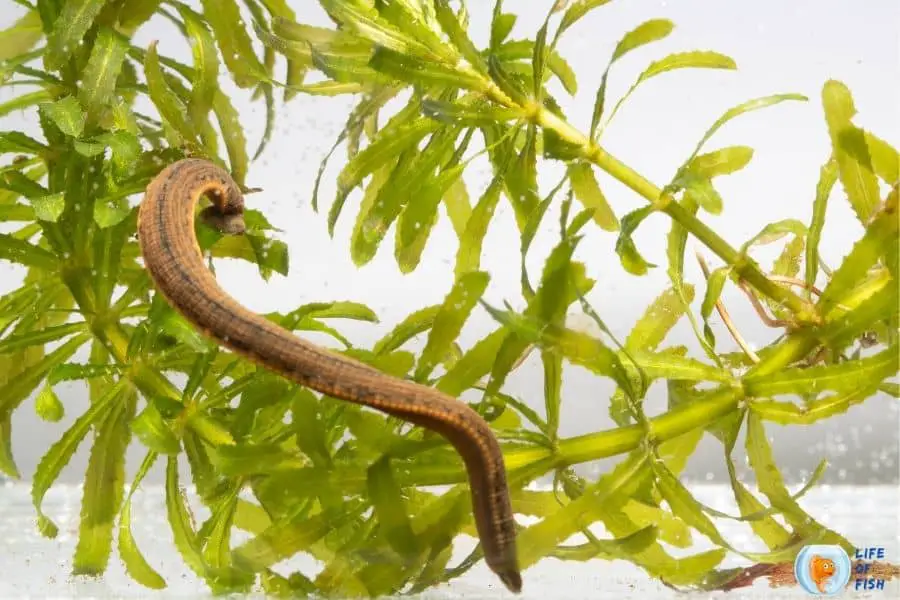
Different ways to get rid of leeches in your aquarium.
Jump To
- 1 Different ways to get rid of leeches in your aquarium.
- 2 Leech life cycle
- 3 How did leeches get in my fish tank?
- 4 Will leeches kill my pond fish?
- 5 What do aquarium leeches eat?
- 6 Who eats leeches?
- 7 Aquarium leech species
- 8 Can leeches survive out of water?
- 9 Are leeches in clean water?
- 10 How to prevent leeches from entering the aquarium?
Salt dip To Get Rid Of Leeches
You can use salt to kill leeches in an aquarium. It needs to be used in high concentration.
It is better to salt dip the plants, fish, and other decorations in another container as the leeches may hide in the gravel if you add salt to the aquarium.
By dipping them in salt-mixed water, they don’t stand a chance to survive.
Salt is a safe ingredient to use in aquariums. When used in the recommended dosage, you can kill many parasites and prevent many infections on your salt-sensitive fish.
Further, salt does not harm the beneficial bacteria in your tank. However, you should use pure sodium chlorides such as Rock salt or Kosher salt.
You should avoid Iodized salt or salt with any additives as those additives may harm your invertebrates and salt-sensitive fish.
But keep in mind not to use this method on rays and certain catfish species.
Furthermore, you can use salt to kill pond leeches as well as aquarium leeches
Copper To Get Rid Of Leeches
Copper mixed chemicals are an excellent choice to kill leeches in an aquarium.
But, YOU MUST NOT USE Copper if you have any shrimps, snails, or any other valuable invertebrates as Copper kills all the invertebrates if mixed with water.
If you have a plant-only aquarium, then Copper is the efficient solution.
Bleach To Get Rid Of Leeches
Bleach can kill aquarium and pond leeches but not their eggs. So, when using bleach, you may need to use it several times over several days.
And also, mixing bleach into the water in the aquarium is also not safe as chlorine may harm fish, plants, and other species in your aquarium.
To get rid of leeches, you have to take out plants, substrate, and decorations and dip them in bleach mixed water.
Remember that You should thoroughly rinse them in running water and dechlorinate them before putting them back in the aquarium.
Hydrogen peroxide To Get Rid Of Leeches
You can use Hydrogen Peroxide to kill some aquarium and pond leeches. Unfortunately, some others survive.
If you have any sensitive fish and plant species, you can first use this solution as it is safe to use H2O2 in an aquarium.
If you still see them alive after few hours, you may have to go with strong medication.
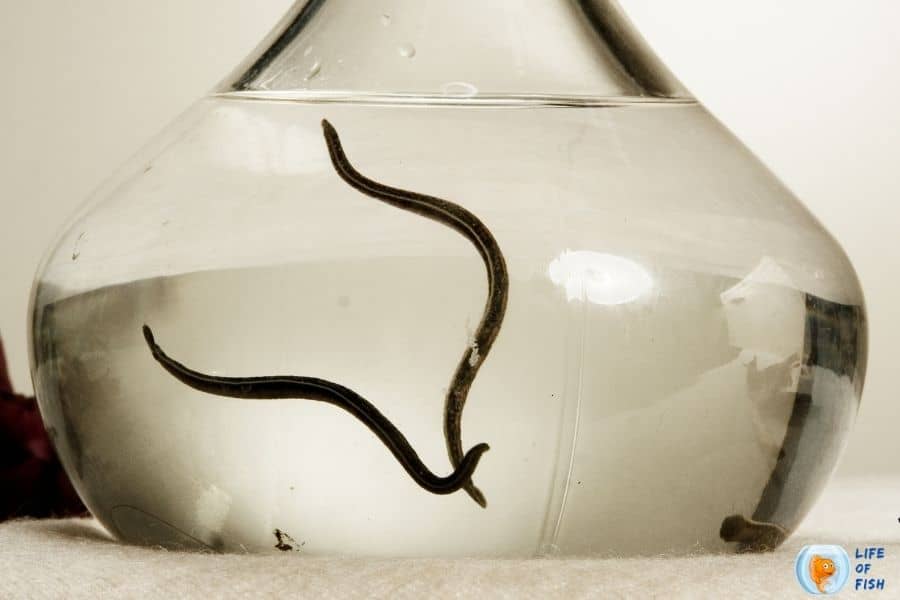
Potassium permanganate dip To Get Rid Of Leeches
Potassium permanganate is another safe solution to get rid of aquarium and pond leeches.
You can mix KMnO4 to an aquarium in a concentration of 2ppm. Any more would harm your fish and plants.
For faster results, you can dip your plants in a 100ppm potassium permanganate solution (not more than 15 minutes).
But, before putting them into the tank, rinse thoroughly with clean water. However, Potassium permanganate can be harmful to sensitive fish and other species.
Manual removal
Manual removal of leeches is safe when they are on the plants, decorations, and substrate.
But, if some bloodsuckers are hooked up with fish, removing them with your hand may not be a good option as it may harm your fish.
In this case, you will have to salt bath your fish to remove the leeches. For sensitive fish species like rays and catfish, you will have to medicate your entire tank with Trichlorofon in a concentration of 0.25mg for every liter of water.
Aquarium leech traps To Get Rid Of Leeches
An aquarium leech trap is a trap to catch planaria and leeches in an aquarium without chemicals or medication.
Many hobbyists had success using this trap, but some did not.
The reason for this is unclear, but for aquariums that have sensitive fish and plant species, you can try using this leech trap to get rid of leeches.
You will have to place bait such as raw pork liver, dead fish, shrimp, and meat in the trap and fill it with water.
Then place the trap in the aquarium with holes facing down on the substrate. Within few hours, the leeches will come to eat the meat inside and trap it inside.
Then you can remove the leeches from the aquarium.
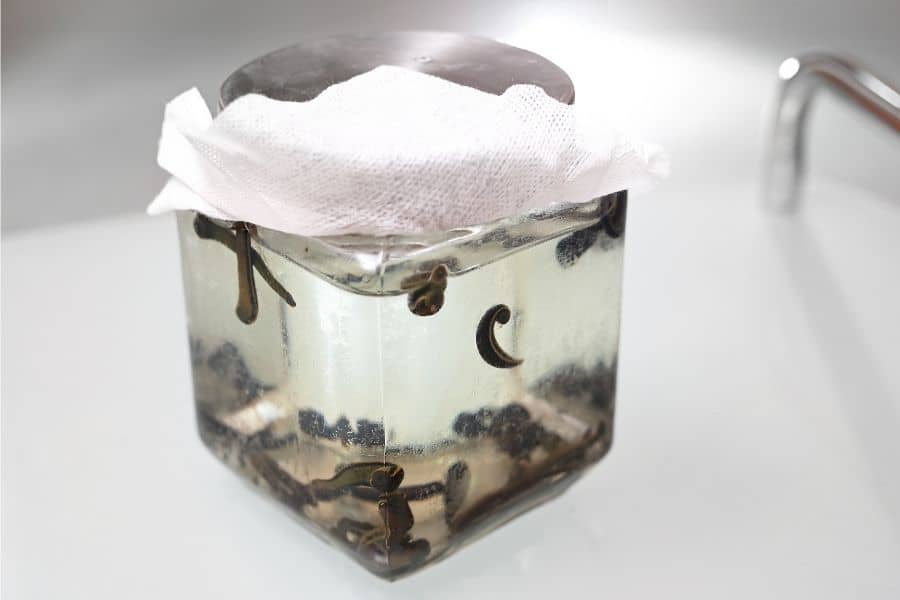
Leech life cycle
They have a complete life cycle. Aquarium and pond Leeches reproduce by sexual reproduction, and the eggs fertilize inside the ovaries.
They make cocoons and attach their fertilized eggs before releasing the cocoon.
The cocoons are then get attached to rocks or plants, and then the eggs hatch, releasing juvenile leeches.
These juvenile leeches grow typically about 15mm to 30mm long and live for about one year. They die after reproducing.
Leech is known as an external parasite and they do not need a host to complete their life cycle.
How did leeches get in my fish tank?
The most common way of introducing leeches into aquariums is through plants and new fish.
The plants may host leech eggs, and once they are introduced, the eggs will hatch, releasing juvenile leeches.
They may also come with pre-owned aquarium equipment, plants, decoration, and substrate.
Leeches may also be present in live food such as bloodworms, blackworms, and tubifex if these species are caught from leech-infested waters.
Most wild-caught fish food contains leeches and other parasites. Therefore, refraining from feeding live food is recommended unless you have cultivated them yourself.
Sometimes leeches can come with new fish. Even though you inspect them carefully there may be a chance leech eggs come attached to new fish.
The best way to get rid of leech in new fish is to quarantine them before introducing them to the main tank.
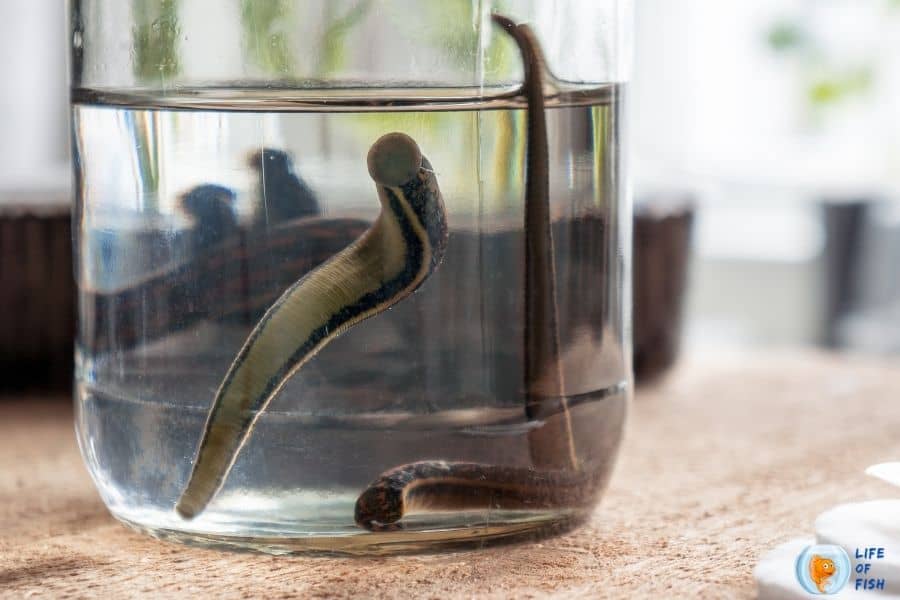
Will leeches kill my pond fish?
Although many leeches do not harm your aquarium inhabitants, some parasitic leeches can actually kill fish.
These parasitic leeches often end up hanging on the healthy fish, sucking up the blood of the fish.
that way they cause anemia and can spread protozoal blood parasites between fish.
So, if not treated immediately, leeches will kill your fish either from sucking up all the blood or spreading parasitic infections.
What do aquarium leeches eat?
Leeches are mostly carnivore species. But, most leaches do not feed on blood. Most leeches prey on insect larvae, worms, or other tiny animals and just eat them.
A small percentage of leeches feed on blood, and most of them prefer to feed on frogs and turtles. About one leech species are known to feed on snails.
Further leeches parasitize on fish and shrimps. If your aquarium faced this kind of leech infestation, then you are in trouble.
Will leeches eat shrimp?
Most leeches will feed on baby shrimps, and some large leaches like the Asian leech can actually eat adult shrimp. Therefore any leech in a shrimp tank would be a problem.
Do leeches eat detritus?
Although most leeches are carnivores and parasitic, some leeches are detrivores. These types of leeches eat detritus for nutrition and pose no threat to aquarium species.
Who eats leeches?
Almost all carnivore freshwater fish eat leeches. Specifically, red ear sunfish, waterfowl, crayfish, and turtles have a good appetite for leeches on lakes and ponds.
In aquariums, loaches and pufferfish are known as leech predators. However, you may want to avoid these fish in aquariums as they also eat small fish, shrimps, and snails.
Aquarium leech species
You will encounter several types of leeches in aquariums. Among them, snail leeches and Asian leeches are most common. Below is a list of leeches you will find in an aquarium.
Snail Leeches
These leeches are common in aquariums and got their name because they drink snail blood.
If your snail population decreases at an alarming rate, the first thing you should check is if your tank has these leeches.
Snail leeches can drain a snail dry just in few days. They are teardrop-shaped, transparent white or brown, and move like caterpillars.
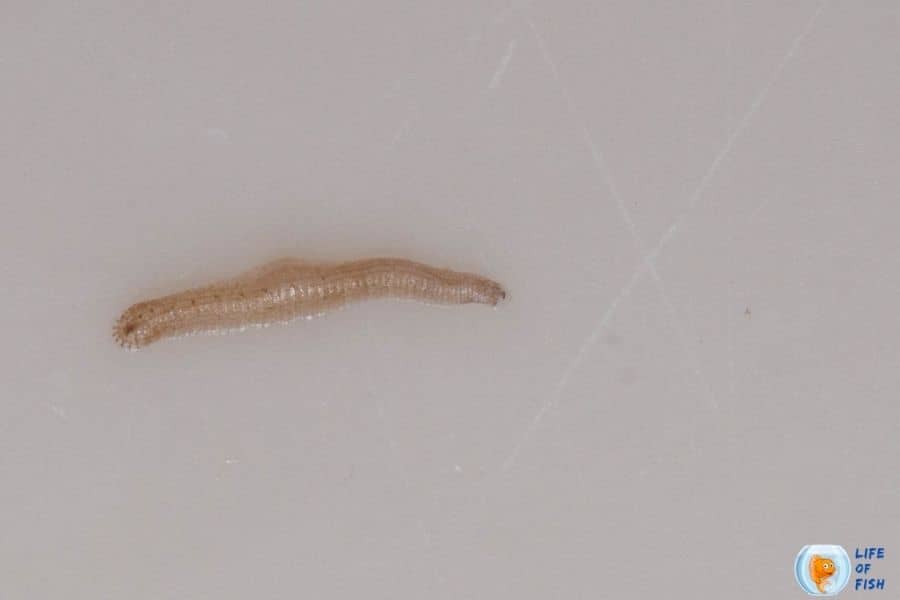
Asian Leeches
Often underestimated leech type in the aquarium trade is the Asian leech.
This brown leech looks more like an earthworm and feeds on small worms, detritus, and shrimps.
In a shrimp tank, the presence of Asian leeches is a real threat. So, immediate action is necessary. Fortunately, you can control these critters with planaria traps.
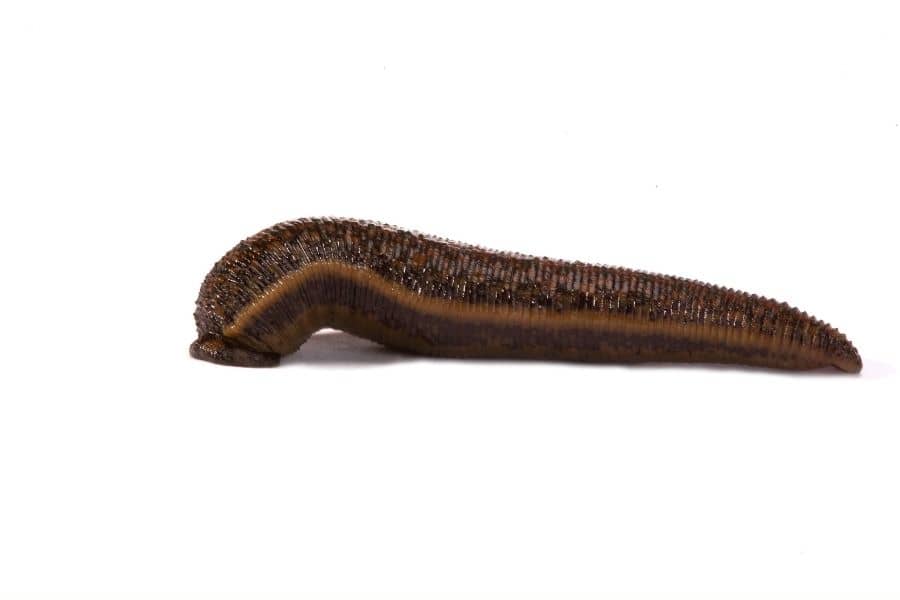
Fish Leeches
These are harmful leeches that attach to fish and suck their blood until the fish dies.
They are long, thin, and worm-like, and often introduced to aquariums through blackworms, bloodworms, and tubifex worms.
Fortunately, fish leech infestations are very rare in aquariums.
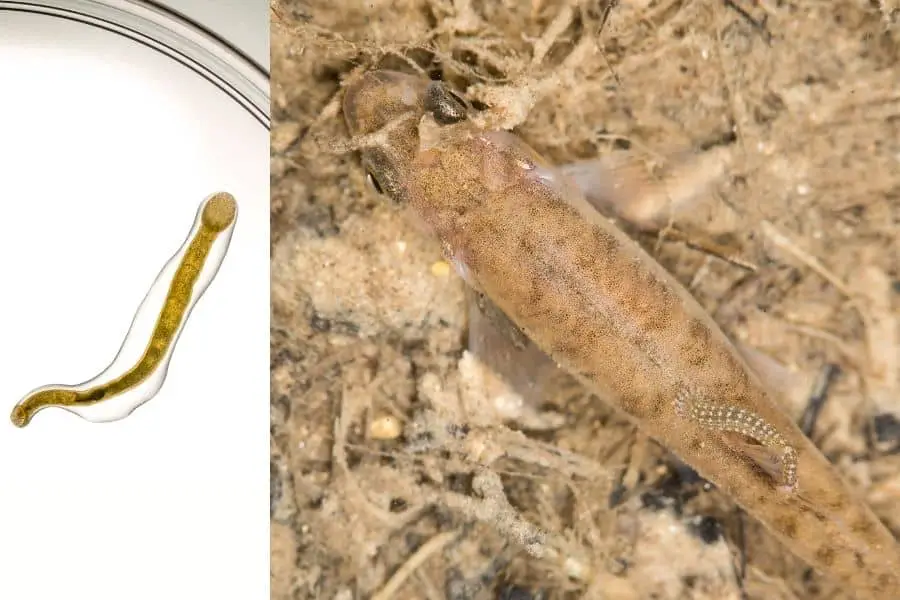
“Detritus worm” Leeches
“Detritus worm” leeches are like detritus worms but are thicker.
They also stay on the substrate like detritus worms and feed on other worms and critters in the substrate. These leeches pose a threat to shrimp tanks as they can kill baby shrimp.
Can leeches survive out of water?
Most leeches are freshwater animals. These freshwater species can not survive out of water.
But, some leeches are amphibious. These amphibious leeches can live in both water and on land.
And also, there are terrestrial leech species that can survive in dry weather for several months in the soil.
Are leeches in clean water?
In the wild, most leeches live in shallow water bodies. These water bodies usually contain clean water. But, they are somewhat resistant to pollution and low oxygen levels.
How to prevent leeches from entering the aquarium?
To prevent leeches from entering the aquarium, you should quarantine everything before introducing them into the aquarium.
You should salt bath the plants, substrate, decorations, and even fish if the fish are wild-caught or bought from an unknown seller.
As plants are the primary source of leeches, it is better to dip new plants in a 5mg/l potassium permanganate solution for about an hour to be safe.
Unless you buy from a reputed seller, do not feed your fish with bloodworms, blackworms, and tubifex because they may be wild-caught ones and carry leech eggs and leeches with them.
Read Next: How To Get Rid Of Duckweeds In Aquarium? | 12 Effective Ways |
